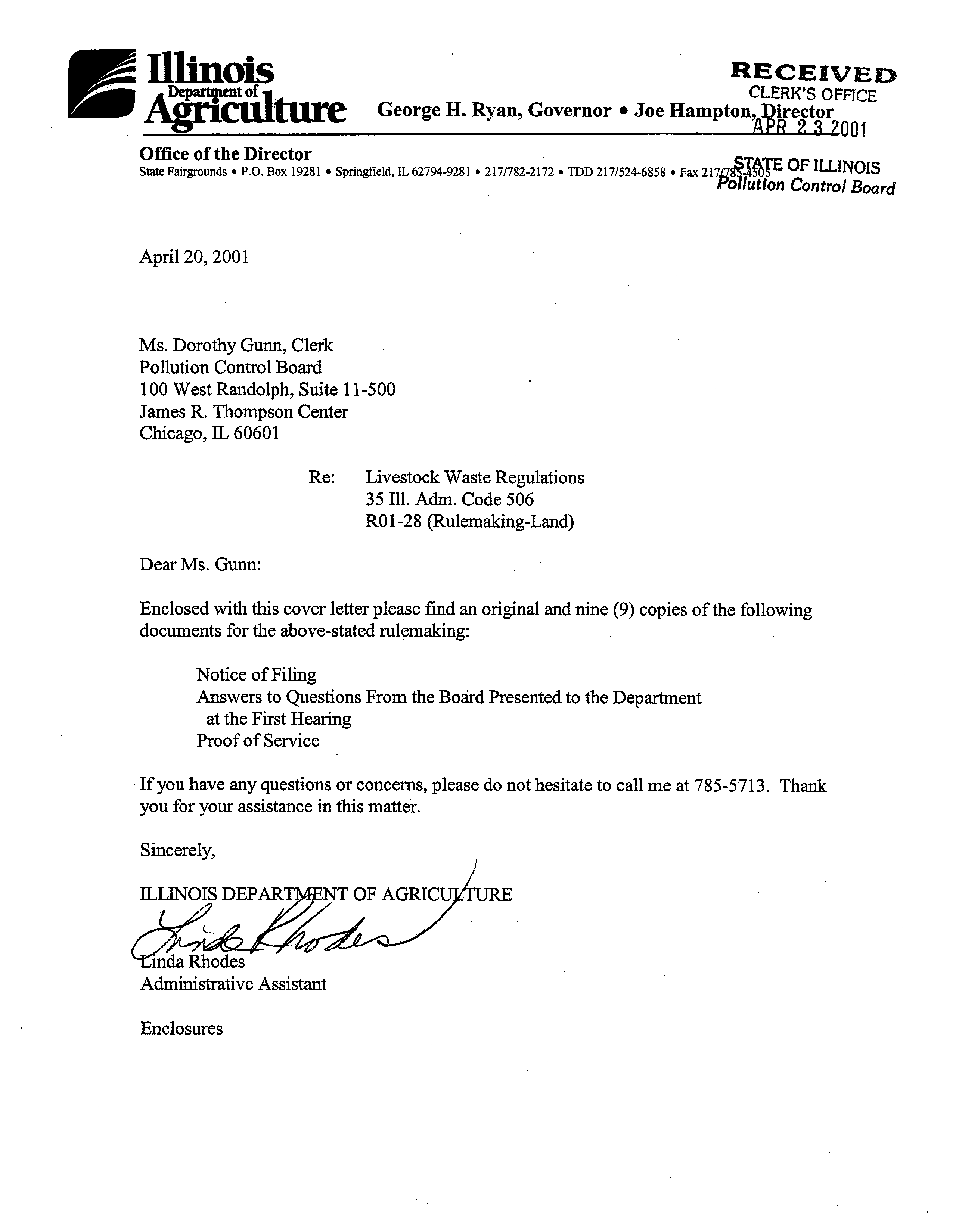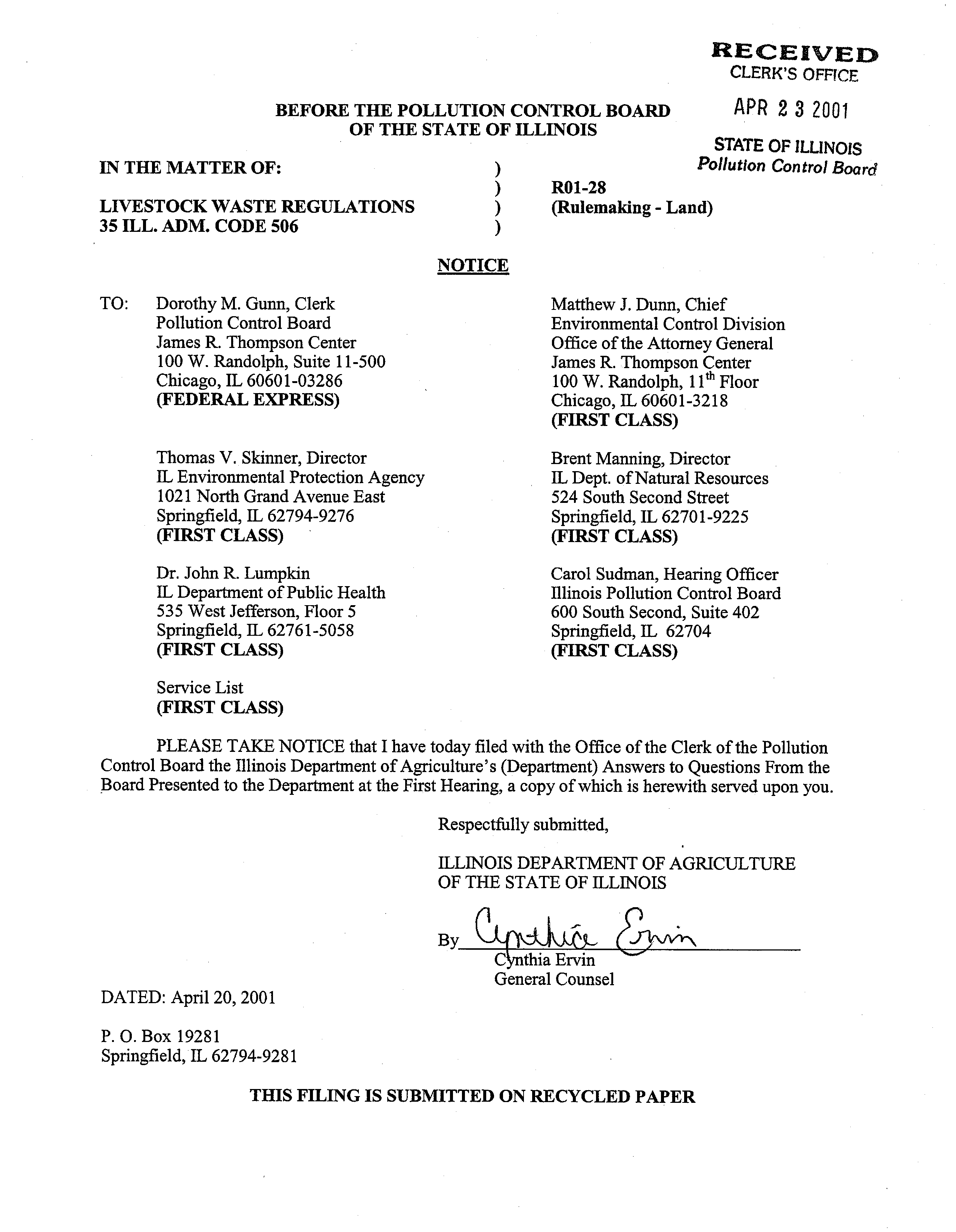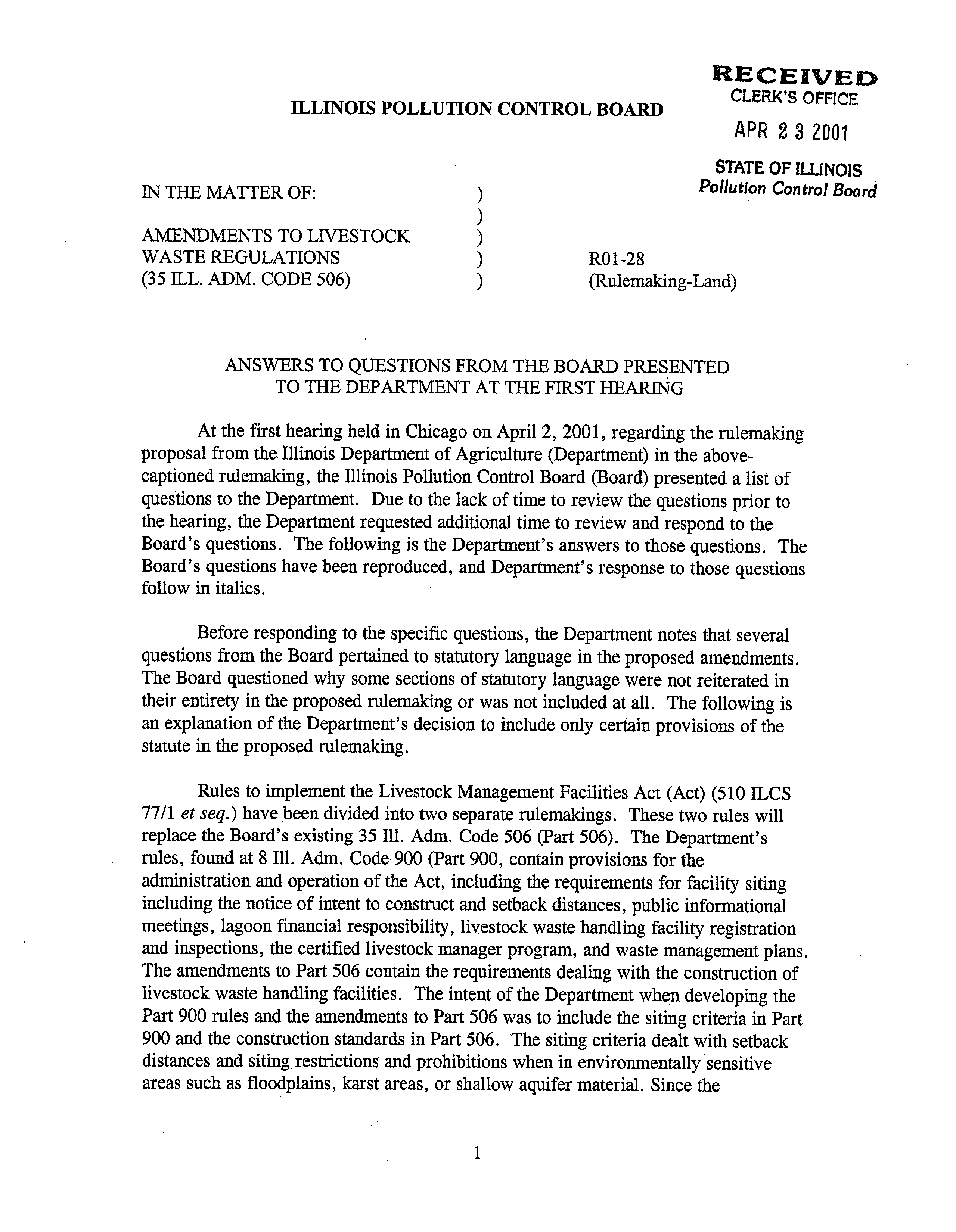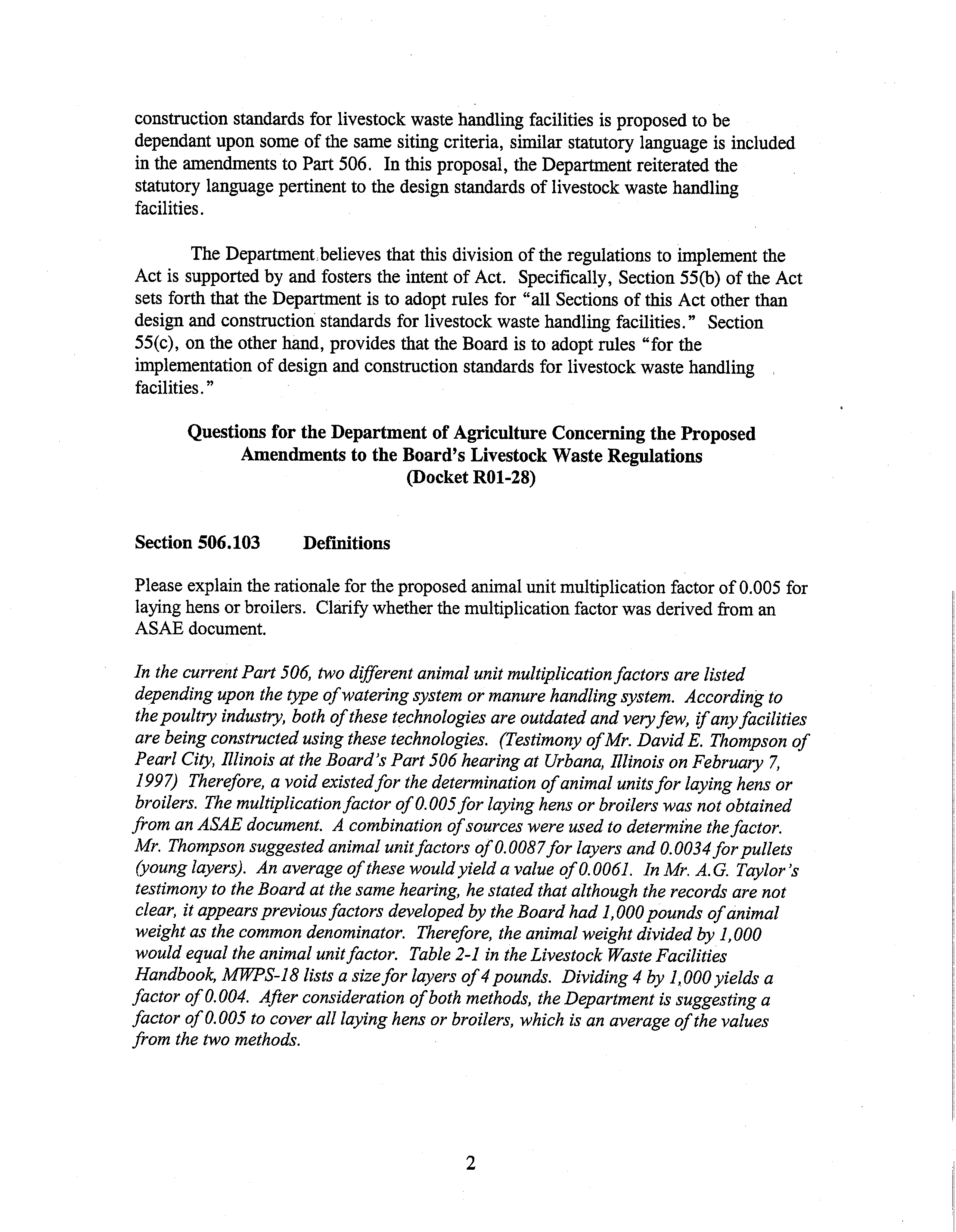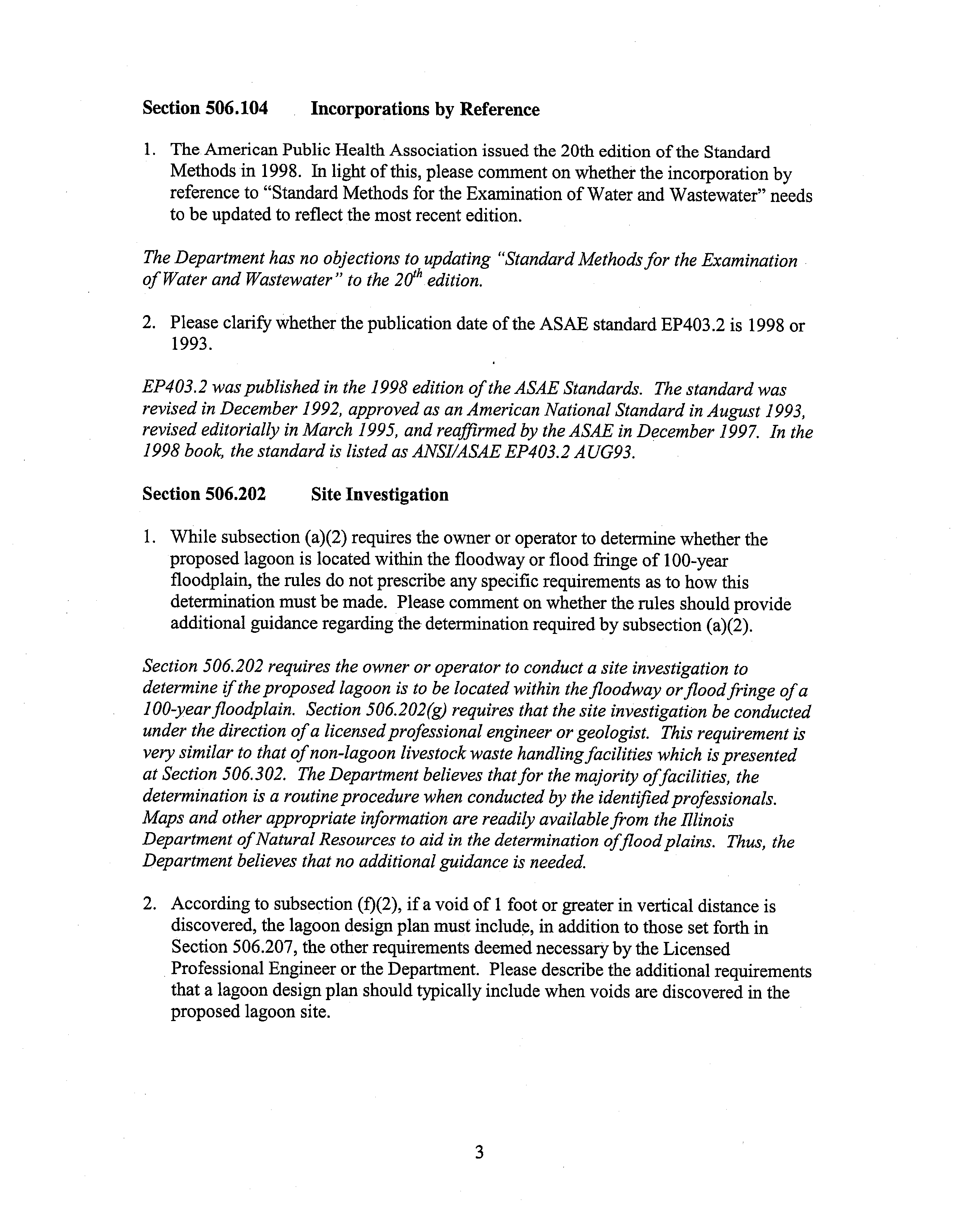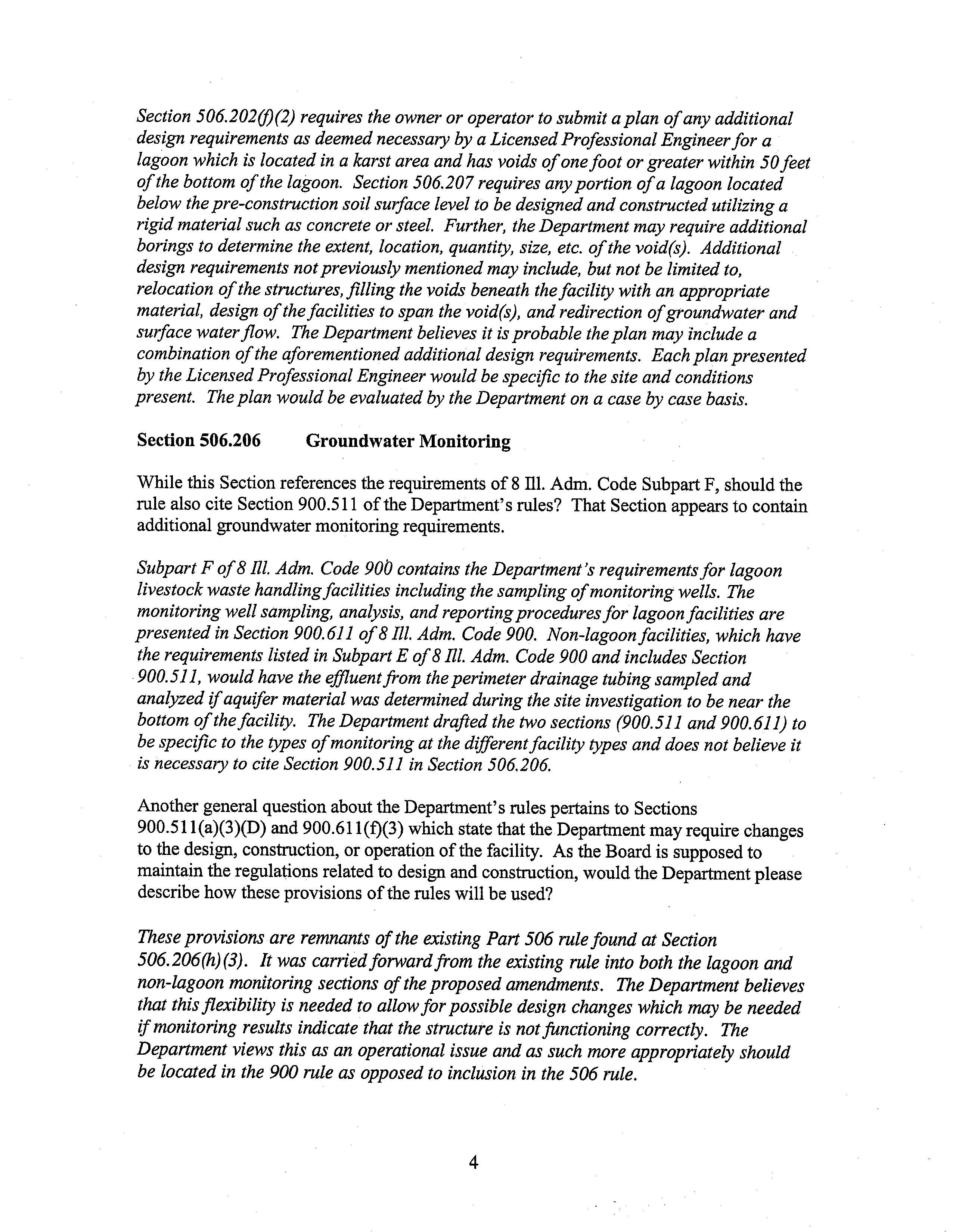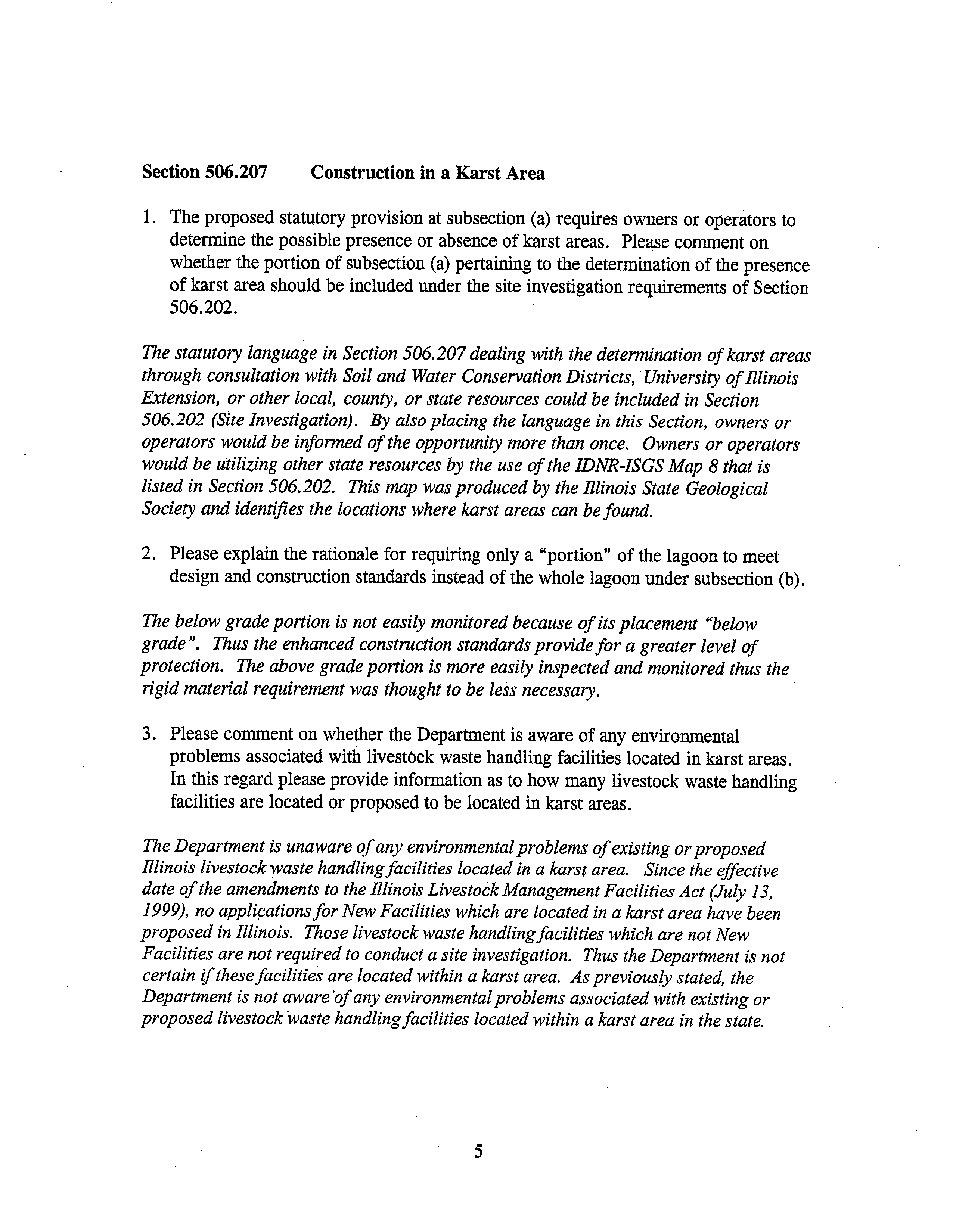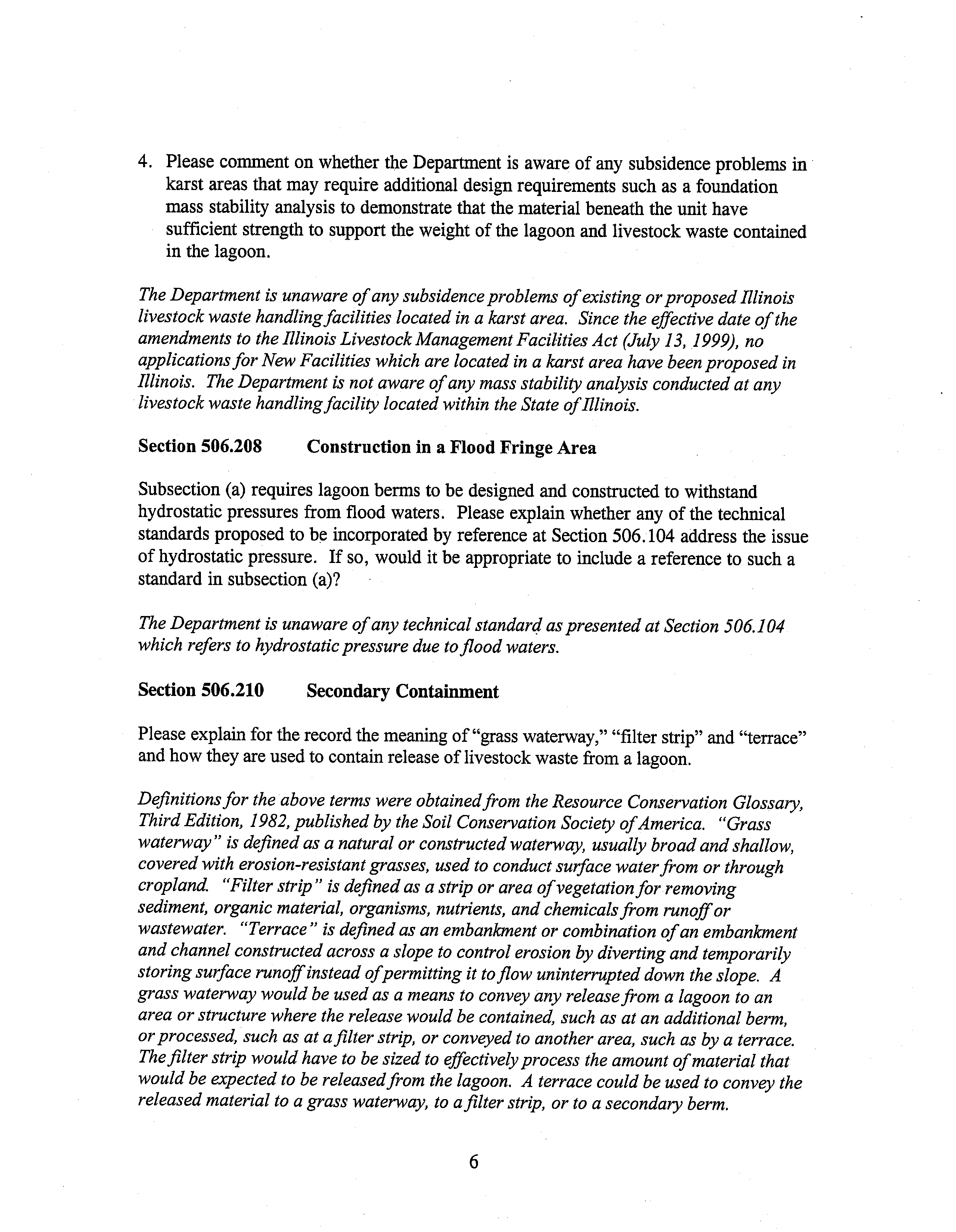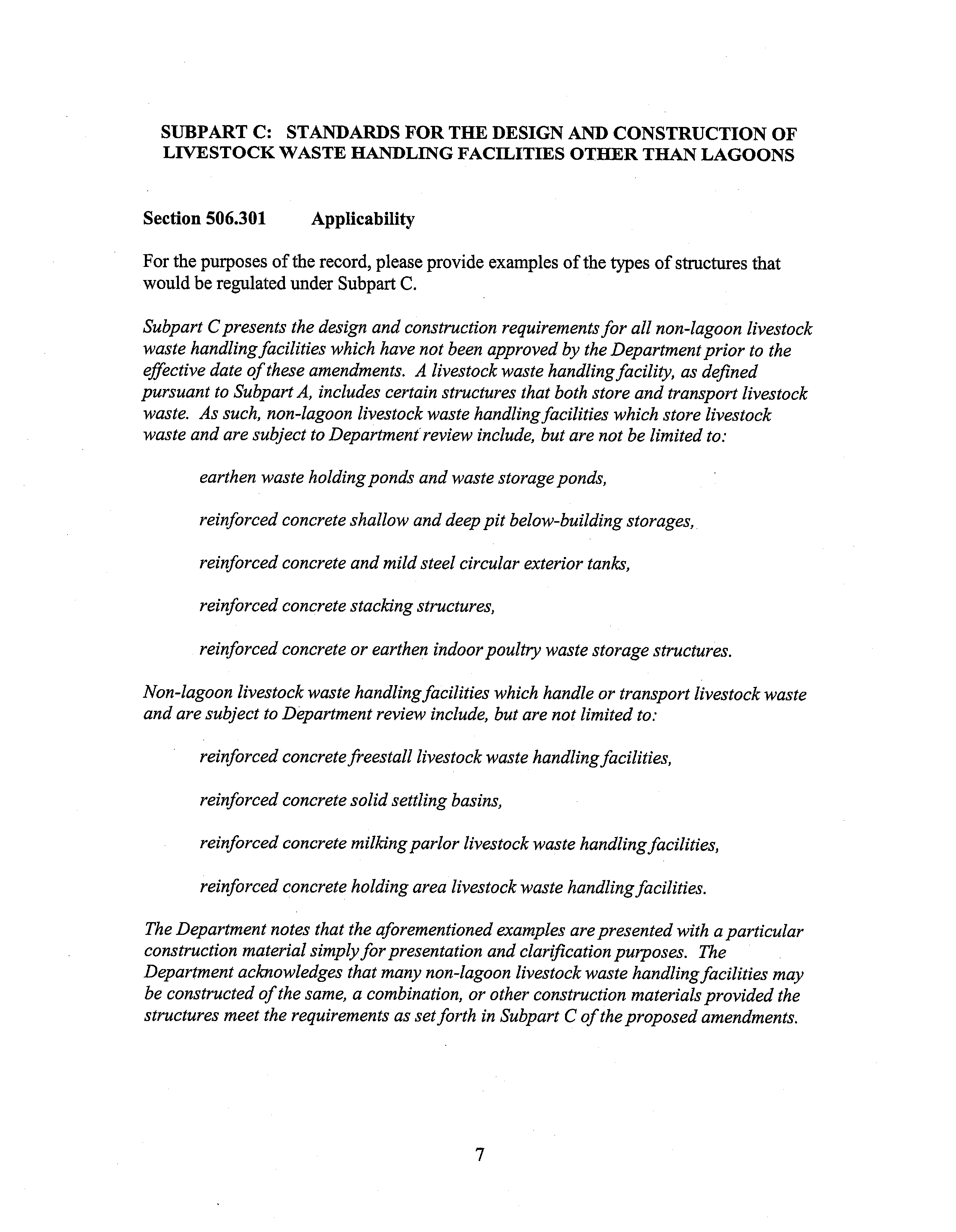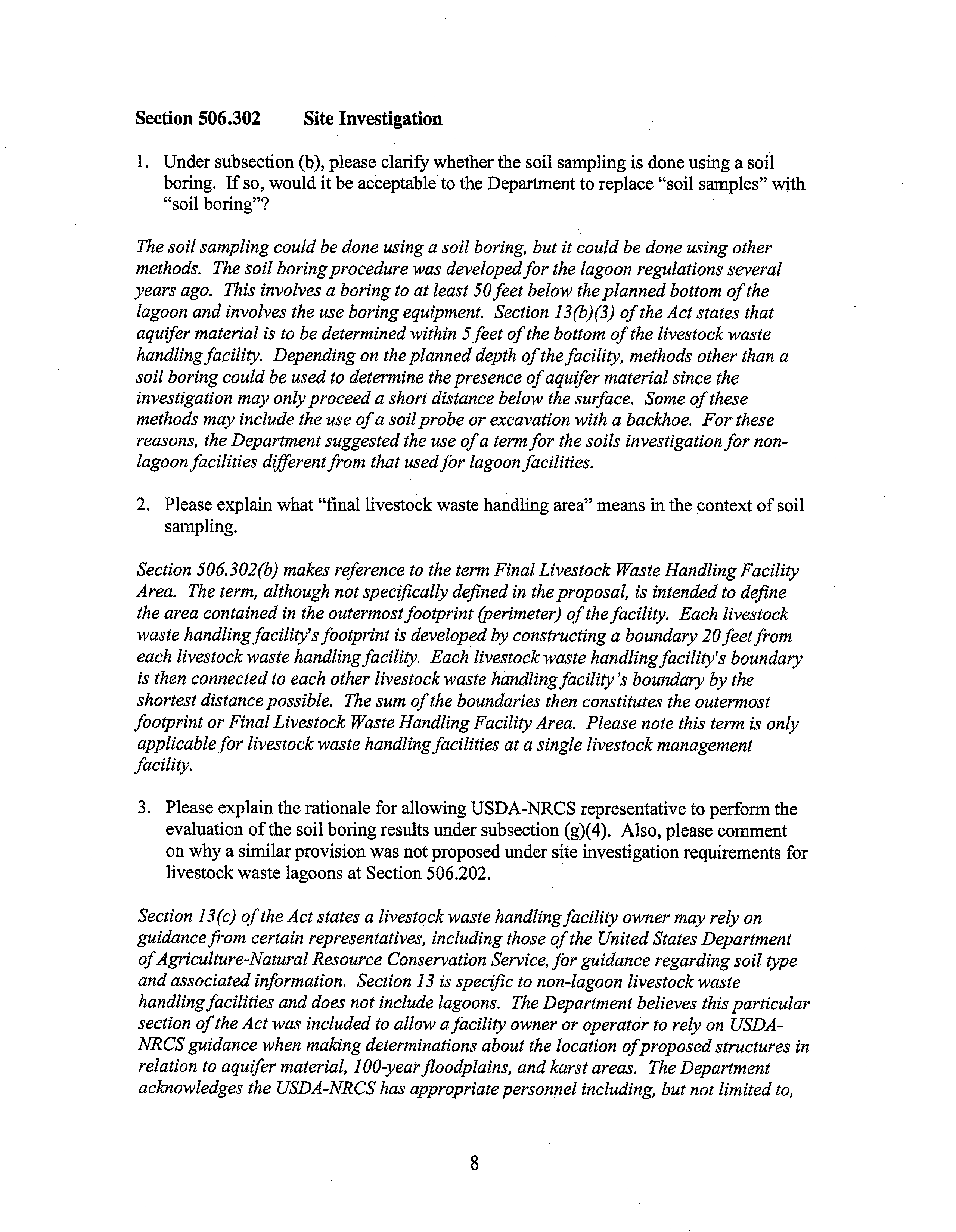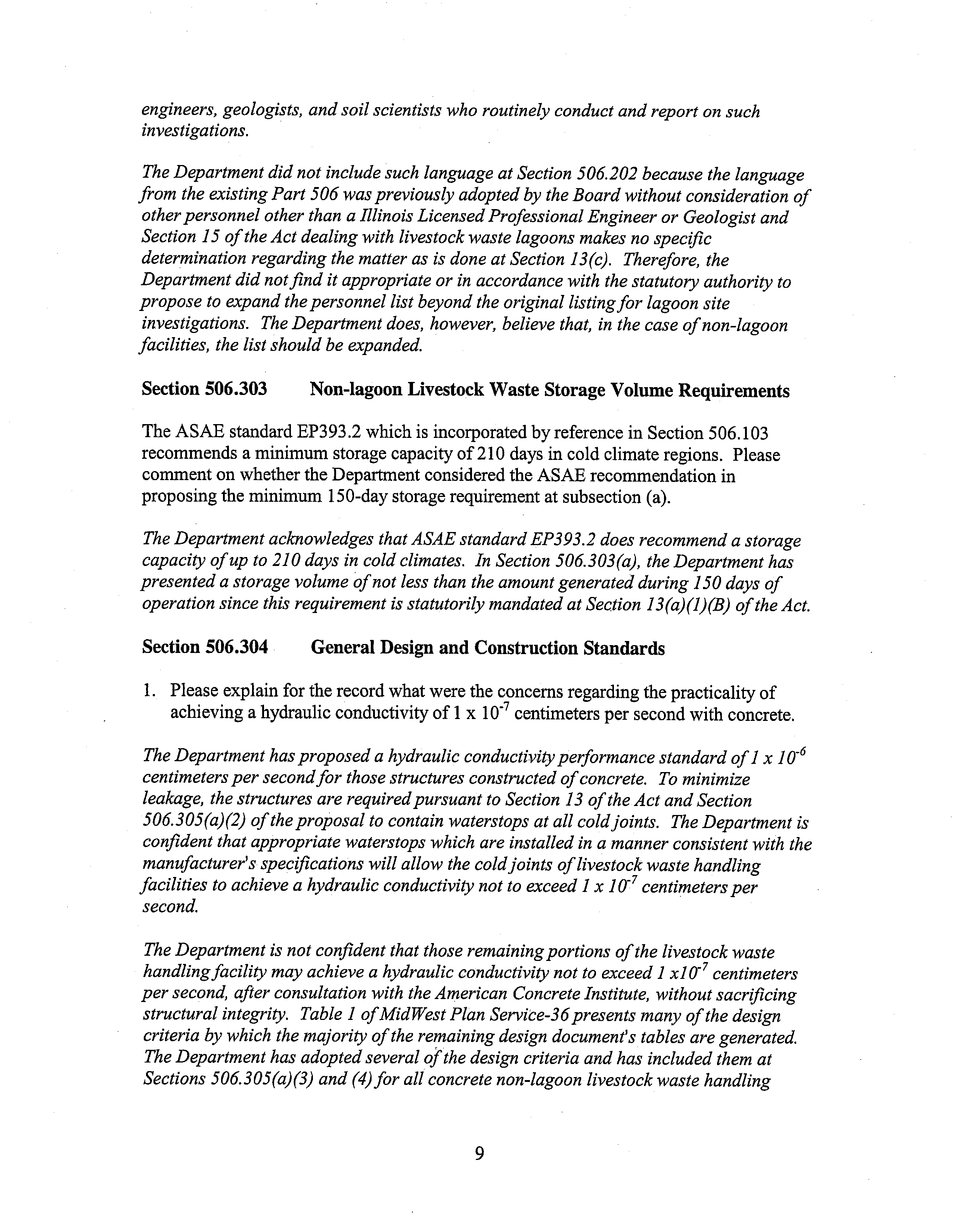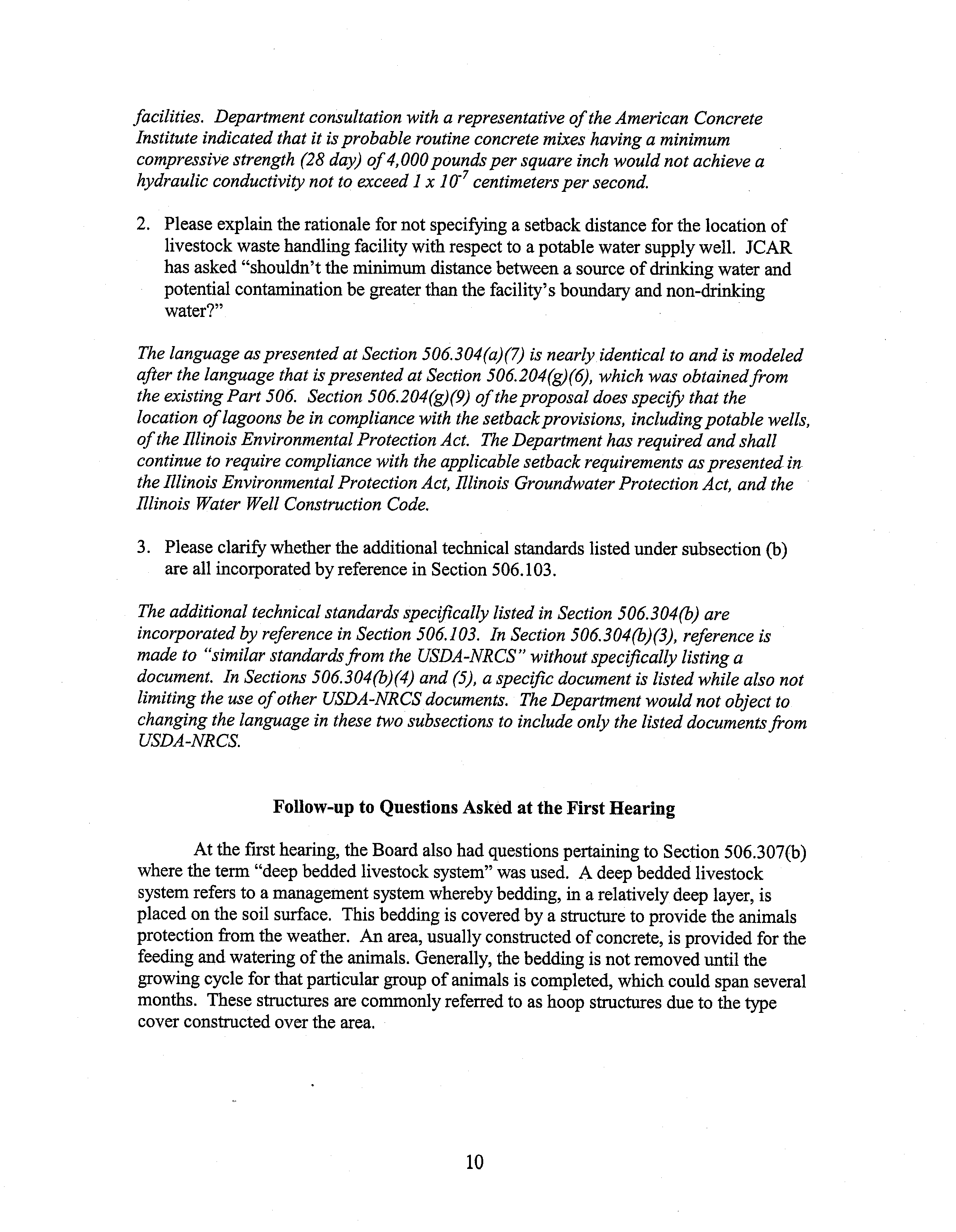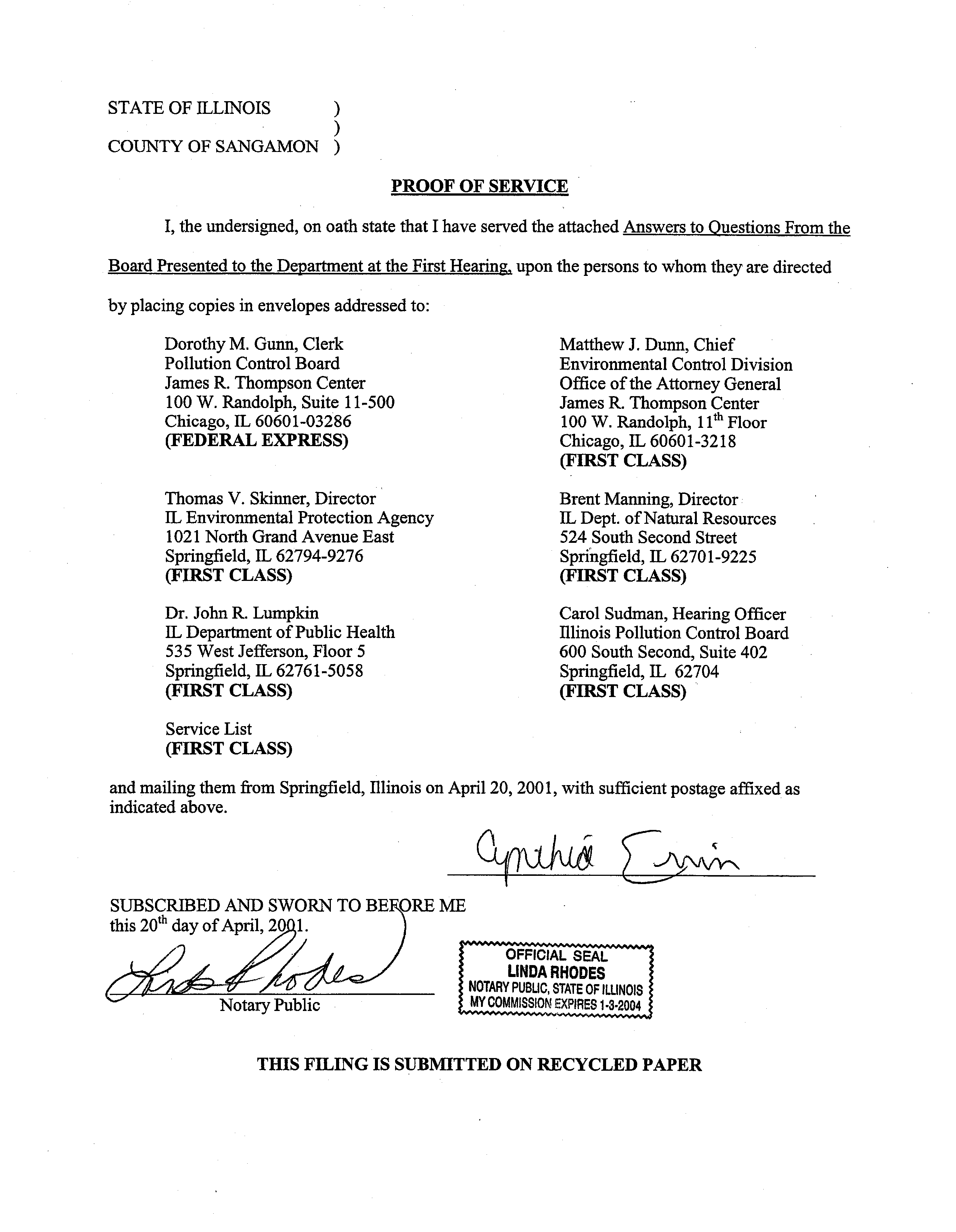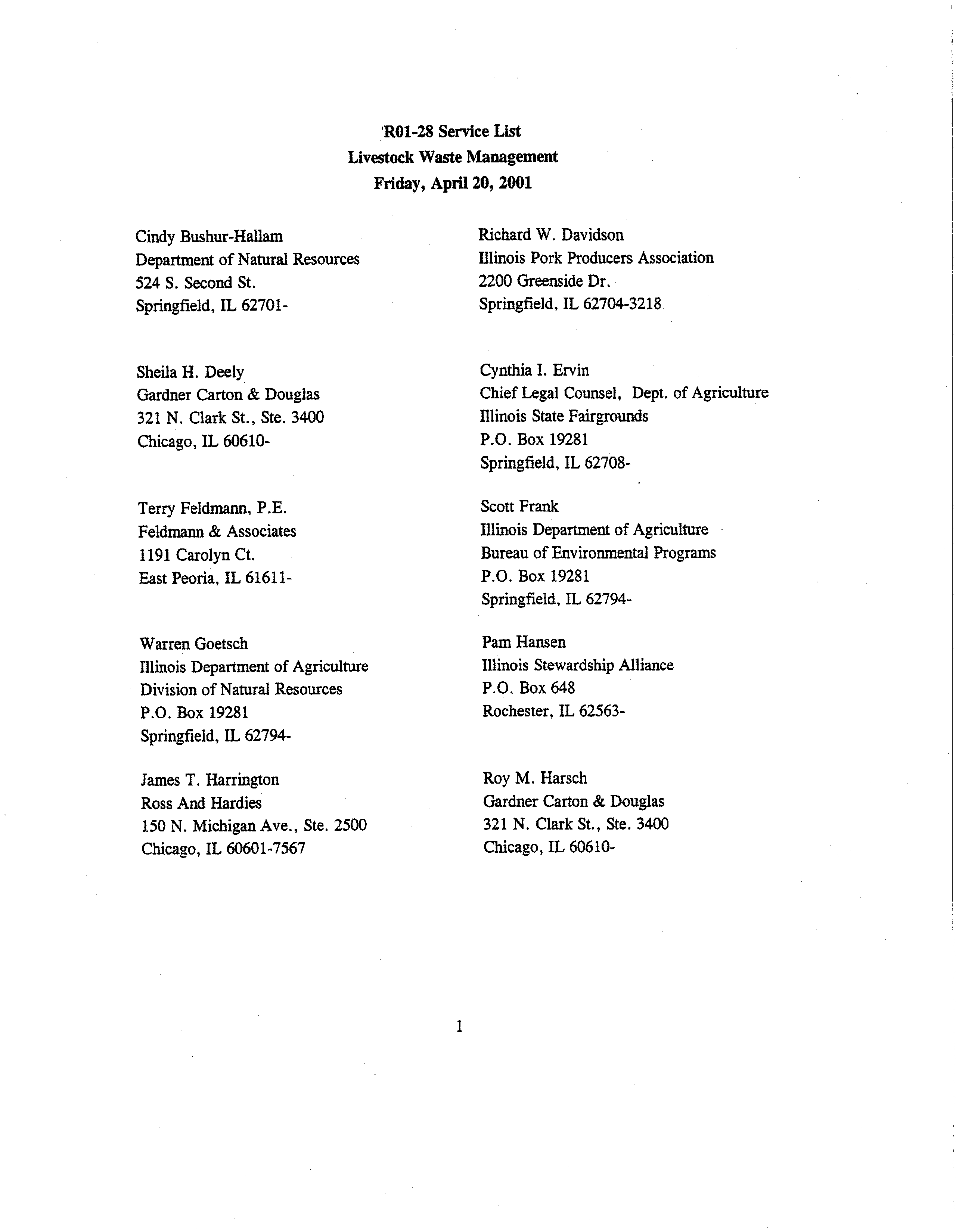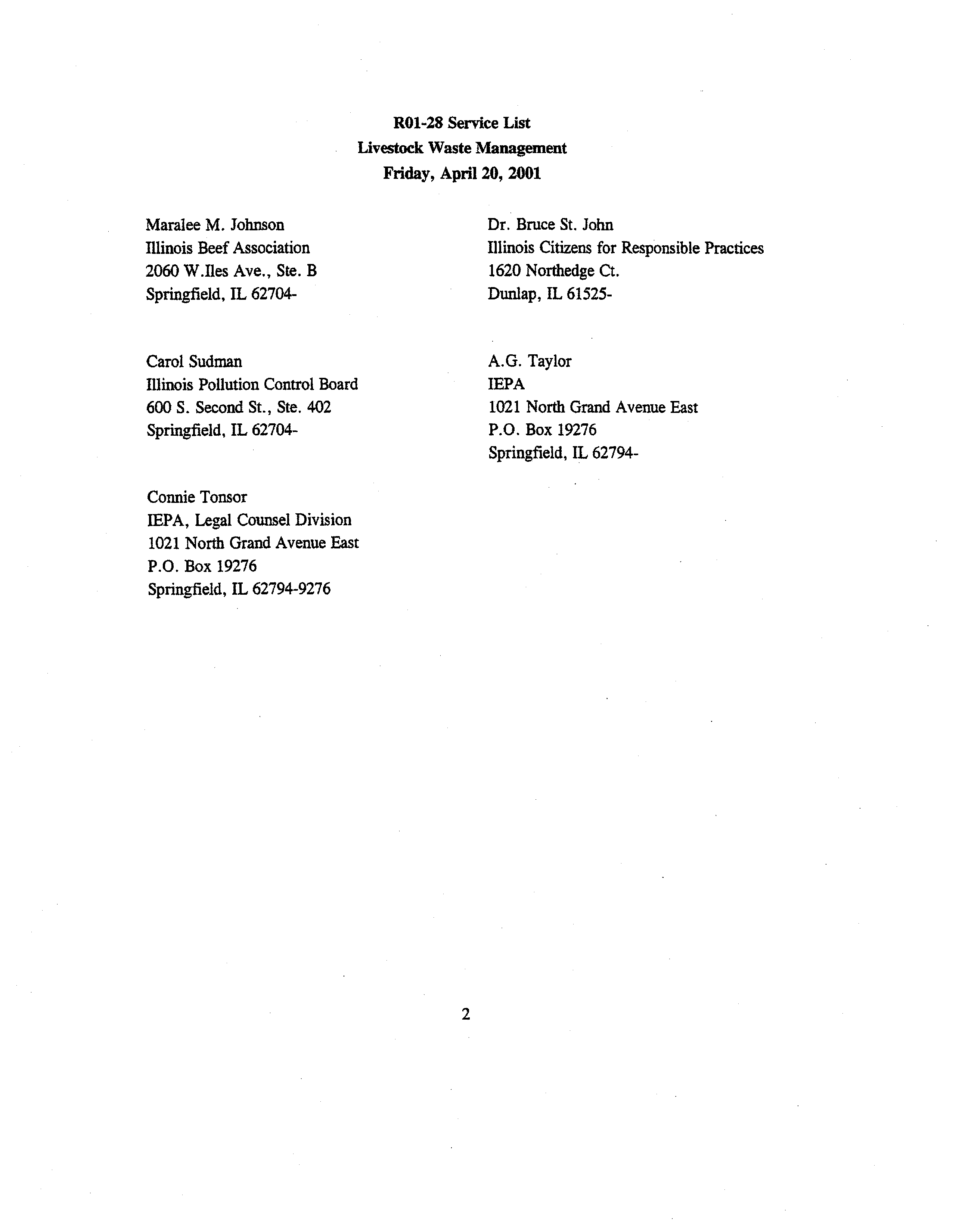illinois
RECEIVED
Dartmentof
CLERK’S OFFICE
A~ricuIturc
George H. Ryan, Governor •Joe
Director
2
~
2001
Office of the Director
~TArEOP I
State
Fairgrounds
•
P.O. Box
19281
•
Springfield, IL 62794-9281
•
217/782-2172
•
TDD 217/524-6858
•
Fax 2171
-~O~
LLINOIS
Pollution Control Board
April 20, 2001
Ms. Dorothy Gunn, Clerk
Pollution Control Board
100 West Randolph, Suite 11-500
James R. Thompson Center
Chicago, IL 60601
Re: Livestock Waste Regulations
35
Ill. Adm. Code
506
RO 1-28 (Rulemaking-Land)
Dear Ms.
Gunn:
Enclosed with this cover letterplease find an original and nine (9) copies ofthe following
documents forthe above-stated rulemaking:
Notice ofFiling
Answers to Questions From the Board Presented to the Department
at the First Hearing
ProofofService
Ifyou have any questions or concerns, please do not hesitate to call me at
785-5713.
Thank
you foryour assistance in this matter.
Sincerely,
Administrative Assistant
Enclosures
RECEIVED
CLERK’S OFFICE
BEFORE THE POLLUTION CONTROL BOARD
OF THE STATE OF ILLINOIS
LIVESTOCK WASTE REGULATIONS
35 ILL. ADM. CODE 506
)
)
)
)
APR
23
2001
STATE OP
ILLINoIs
Pollution
Control Board
RO1-28
(Rulemaking
-
Land)
NOTICE
TO:
Dorothy M. Gunn, Clerk
Pollution Control Board
James R. Thompson Center
100 W. Randolph, Suite
11-500
Chicago, IL 6060 1-03286
(FEDERAL EXPRESS)
Thomas V. Skinner, Director
IL Environmental Protection Agency
1021
North Grand Avenue East
Springfield, IL 62794-9276
(FIRST CLASS)
Dr. John R. Lumpkin
IL Department ofPublic Health
535
West Jefferson, Floor 5
Springfield, IL 62761-5058
(FIRST CLASS)
Matthew J. Dunn, Chief
Environmental Control Division
Office ofthe AttorneyGeneral
James R. Thompson Center
100 W. Randolph,
1
1th Floor
Chicago, IL 6060 1-3218
(FIRST CLASS)
Brent Manning, Director
IL Dept. ofNatural Resources
524 South Second Street
Springfield, IL 6270 1-9225
(FIRST CLASS)
Carol Sudman, Hearing Officer
illinois Pollution Control Board
600 South Second, Suite 402
Springfield, IL
62704
(FIRST CLASS)
Service List
(FIRST CLASS)
PLEASE TAKE NOTICE that I have today filedwith the Office ofthe Clerk ofthe Pollution
Control Board the Illinois
Department of Agriculture’s(Department) Answers to Questions From the
Board Presentedto the Department at the First Hearing, a copy ofwhich is herewith served upon you.
Respectfully submitted,
ILLINOIS DEPARTMENT OF AGRICULTURE
OF THE STATE OF ILLINOIS
DATED: April 20,2001
By___
General Counsel
P. 0. Box 19281
Springfield, IL 62794-9281
IN THE
MATTER OF:
THIS FILING IS SUBMITTED
ON RECYCLED PAPER
RECEIVED
ILLINOIS POLLUTION CONTROL
BOARD
KS
OFFiCE
APR
2 32001
STATE OF ILLINOIS
IN THE MATTER OF:
)
Pollution Control Board
)
AMENDMENTS TO LIVESTOCK
)
WASTE REGULATIONS
)
RO1-28
(35
ILL. ADM. CODE 506)
)
(Rulemaking-Land)
ANSWERS TO QUESTIONS FROM THE BOARD PRESENTED
TO THE
DEPARTMENTATTHE FIRST HEARING
At the first
hearing held in Chicago on April 2,
2001,
regarding the rulemaking
proposal from
the Illinois
Department of Agriculture (Department) in the above-
captioned rulemaking, the Illinois Pollution Control Board (Board) presented a list of
questions to the Department.
Due to the lack of time to review the questions prior to
the hearing, the Department requested additional time to review and respond to the
Board’s questions.
The
following
is
the Department’s
answers
to those questions.
The
Board’s questions have beenreproduced, and Department’sresponse to those
questions
follow in italics.
Before responding to the specific questions,
the Department notes that several
questions
from the Board pertained
to
statutory language in the proposed amendments.
The Board questioned why some sections of statutory
language were not reiterated in
their entirety
in the proposed rulemaking or was not included at all.
The
following is
an explanation of the Department’sdecision to
include only certain provisions of the
statute in the proposed rulemaking.
Rules to implement the Livestock Management Facilities Act
(Act)
(510 ILCS
77/1
et seq.)
have been
divided into two separate rulemakings.
These two rules will
replace the Board’s existing
35
Ill. Adm.
Code 506 (Part
506).
The
Department’s
rules, found at 8 Ill. Adm.
Code 900 (Part 900,
contain provisions for the
administration and operation of the Act, including
the requirements for facility siting
including
the notice of intent to construct and
setback distances, public informational
meetings,
lagoon financial responsibility, livestock waste handling
facility registration
and inspections,
the certified livestock manager program, and waste
management plans.
The
amendments to Part 506
contain therequirements dealing with the construction of
livestock waste handling facilities. The intent of the Department when developing the
Part 900 rules and the amendments to
Part 506 was to include the siting criteria in Part
900 and the construction standards in Part 506. The siting criteria dealt with setback
distances and siting restrictions and prohibitionswhen in environmentally sensitive
areas such as floodplains, karst areas, or shallow aquifer material. Since the
1
construction standards for livestock waste handling facilities is proposed to be
dependant upon some of the same siting criteria,
similar statutory language is included
in the amendments to Part 506.
In this proposal,
the Department reiterated the
statutory language pertinent to the design standards of livestock waste handling
facilities.
The Department believes that
this division of the regulations to implement the
Act is supported by and fosters the intent of Act.
Specifically, Section
55(b)
of the Act
sets forth that the Department is to adopt rules for “all Sections of this Act other than
design and construction standards for livestock waste handling facilities.”
Section
55(c),
on the other hand, provides that the Board is to adopt rules “for the
implementation of design and construction standards for livestock waste handling
facilities.”
Questions
for the Department of Agriculture Concerning the Proposed
Amendments to the Board’s LivestockWaste Regulations
(Docket RO1-28)
Section 506.103
Definitions
Please explain the rationale forthe proposed animal unit multiplication factor of0.005 for
laying hens or broilers.
Clarif~r whether the multiplication factor was derived from an
ASAE document.
In the current Part 506,
Iwo dWferent animal unit multiplication factors are listed
depending upon the type ofwateringsystem ormanure handlingsystem.
According to
thepoultry industry,
both ofthese technologies are outdated and veryfew,
~fanyfacilities
are being constructed using these technologies.
(Testimony ofMr. David E.
Thompson of
Pearl City,
illinois at the Board’sPart 506 hearing at
Urbana, Illinois on February
7,
1997) Therefore,
a void existedfor the determination ofanimal unitsfor laying hens or
broilers.
The multiplicationfactor of 0.005for laying hens or broilers was not obtained
from an ASAE document.
A combination ofsources were usedto
determine thefactor.
Mr.
Thompson suggested animal unitfactors of 0.0087for layers and 0.Oo34forpullets
(young layers).
An average ofthese would yield a value of0.0061.
In Mr. A. G.
Taylor’s
testimony to
the Board at the same hearing,
he stated that although the records are not
clear,
it appears previousfactors developed by theBoard had 1,000 pounds ofanimal
weight as the common denominator.
Therefore,
the animal weight divided by 1,000
would equal the animal unitfactor.
Table 2-1 in the Livestock Waste Facilities
Handbook, MWPS-18 lists a sizefor layers of4 pounds.
Dividing 4 by
1,000 yields
a
factor of 0.004.
After consideration ofboth methods, the Department is suggesting a
factor of 0.005
to cover all laying hens or broilers, which is
an
average ofthe values
from the two methods.
2
Section
506.104 Incorporations by Reference
1.
The American Public Health Association issued the 20th edition ofthe Standard
Methods
in 1998.
In light ofthis, please comment on whether the incorporation by
reference to “Standard Methods for the ExaminationofWater and Wastewater” needs
to be updated to reflect the most recent edition.
The Department has no objections
to updating
“StandardMethodsfor the Examination
of Water and Wastewater”
to the
2fj/h
edition.
2.
Please clarify whether the publication date of the ASAE standard EP403.2
is
1998 or
1993.
EP403.2 waspublished in the 1998 edition oftheASAE Standards.
The standard was
revised in December 1992, approved as an American National Standard in August 1993,
revised editorially in March
1995,
and reaffirmedby theASAE in December 1997.
In the
1998 book,
the standard is listed as ANSI/ASAEEP403.2 A UG93.
Section 506.202
Site Investigation
1.
While subsection (a)(2) requires the owner or operator to determine whether the
proposed lagoon is located within the floodway or flood fringe of 100-year
floodplain,
the rules do not prescribe any specific requirements as to how this
determination must be made. Please comment on whetherthe rules should provide
additional guidance regarding the determination required by subsection (a)(2).
Section 506.202 requires the owner or operator to conducta site investigation
to
determine ~the
proposed lagoon is to
be located within thefloodway orfloodfringe ofa
100-yearfloodplain.
Section 506.202(g) requires that the site investigation be conducted
under the direction ofa
licensedprofessional engineeror geologist.
This requirement is
very similar to that ofnon-lagoon livestock waste handlingfacilities which is presented
at Section 506.302.
The Department believes thatfor the majority offacilities, the
determination is
a routineprocedure when
conducted by the identifiedprofessionals.
Maps and other appropriate information are readily availablefrom the Illinois
Department ofNatural Resources to aid in
the determination offlood plains.
Thus,
the
Department believes that no additional guidance is needed.
2.
According to subsection (f)(2), if a void of 1
foot or greater in vertical distance is
discovered, the lagoon design plan must include, in addition to those set forth in
Section 506.207, the other requirements deemed necessary by the Licensed
Professional Engineer orthe Department.
Please describe the additional requirements
that a lagoon design plan should typically include when voids are discovered in the
proposed lagoon site.
3
Section
506.202W(2) requires the owner or operator to submit a plan ofany additional
design
requirements as deemednecessary by a LicensedProfessional Engineerfor
a
lagoon which is located in a karst area and has
voids ofonefoot or greater within
50feet
ofthe bottom ofthe lagoon.
Section 506.20 7 requires any portion ofa
lagoon located
below thepre-construction soil surface level to be designed and constructed utilizing a
rigid material such as concrete or steel.
Further, the Department may require additional
borings to determine the extent, location,
quantity,
size, etc. of the void(s).
Additional
design requirements not previouslymentioned may include,
but not be limited to,
relocation ofthe structures, filling the voids
beneath thefacility with an appropriate
material, design ofthefacilities to span the void(s),
and redirection ofgroundwater and
surface waterflow.
The Department believes it is probable theplan may include a
combination ofthe aforementioned additional design requirements.
Eachplan presented
by the Licensed Professional Engineer would be specific to
the site and conditions
present.
The plan would be evaluated by the Department on
a case by case basis.
Section 506.206
Groundwater Monitoring
While this Section references the requirements of 8
111.
Adm. Code Subpart F, should the
rule also cite Section 900.511 ofthe Department’s rules? That Section appears to contain
additional groundwater monitoring requirements.
Subpart F of8 ill. Adm. Code
900 contains the Department’s requirementsfor lagoon
livestock waste handlingfacilities including the sampling ofmonitoring wells.
The
monitoring well sampling, analysis,
and reporting proceduresfor lagoonfacilities are
presented in Section 900.611 of 8 Ill. Adm. Code 900.
Non-lagoonfacilities,
which have
the requirements listed in Subpart E of8 Ill. Adm. Code 900 and includes Section
900.511, would have the effluentfrom theperimeter drainage tubingsampled and
analyzed ~faqu~fermaterial was determinedduring the site investigation
to be near the
bottom ofthefacility.
The Departmentdrafted the two sections (900.511 and 900.611) to
be specific to
the types ofmonitoring at the differentfacility types and does not believe it
is necessaly to cite Section 900.511
in Section 506.206.
Another general question about the Department’srules pertains to
Sections
900.51 1(a)(3)(D) and 900.61 l(f)(3) which state that the Department may require changes
to the design, construction, or operation ofthe facility.
As
the Board is supposed to
maintain the regulations related to
design and construction, would the Departmentplease
describe how these provisions ofthe rules will
be used?
These provisions are remnants of the existing Part 506 rulefound at Section
506.206(h)(3).
It was carried forwardfrom
the existing rule into both the lagoon and
non-lagoon monitoring sections of the proposed amendments.
The Department believes
that thisflexibility
is needed to allowfor possible design changes which may be needed
if monitoring results indicate that the structure is
notfunctioning correctly.
The
Department views this as an operational issue
and as such more appropriately should
be located in the 900 rule as opposed to inclusion in the 506 rule.
4
Section 506.207
Construction in
a Karst Area
1.
The proposed statutory provision at subsection (a) requires owners or operators to
determine the possible presence or absence of karst areas. Please comment on
whether the portion of subsection (a) pertaining to the determination of the presence
of karst area should be included under the site investigation requirements of Section
506.202.
The statutory language in Section 506.207 dealing with the determination ofkarst areas
through consultation with
Soil and Water Conservation Districts,
University of illinois
Extension, or other local,
county,
or state resources could be included in
Section
506.202
(Site Investigation). By also placing the language in this Section,
owners or
operators would be informed of the opportunity more than once.
Owners or operators
would be
utilizing other state resources by
the use of the IDNR-ISGS Map 8 that is
listed in Section 506.202.
This map was produced by the Illinois State Geological
Society and identifies the locations
where karst areas can be found.
2.
Please explain the rationale for requiring only
a “portion” of the lagoon to meet
design and construction standards
instead of the whole lagoon under subsection (b).
The below grade portion is not easily monitored because of its placement
“below
grade
“.
Thus the enhanced construction standards providefor a greater level of
protection.
The above grade portion
is more easily inspected and monitored thus the
rigid material requirement was thought to be less necessary.
3.
Please comment on whether the Department is aware
of any environmental
problems
associated with livestock waste handling facilities located in karst areas.
In this regard please provide information as to how many livestock waste handling
facilities are located or proposed to be located in karst areas.
The Department is unaware ofany environmentalproblems ofexisting orproposed
Illinois livestock waste handlingfacilities
located in a karst area.
Since the effective
date ofthe amendments to
theIllinois Livestock ManagementFacilities Act (July 13,
1999), no applicationsfor New Facilities which are located in a karst area have been
proposed in Illinois.
Those livestock waste handlingfacilities which are not New
Facilities are not required to conduct a site investigation.
Thus the Department is not
certain
~f
thesefacilities are located within
a karst area.
As previouslystated,
the
Department is not aware ofany environmentalproblems associated with existing or
proposed livestock waste handlingfacilities located within a karst area in
the state.
5
4.
Please comment on whether the Department is aware of any subsidence problems in
karst areas that may require additional design requirements
such as a foundation
mass stability analysis to demonstrate that the material beneath the unit have
sufficient strength to support the weight of the lagoon and livestock waste contained
in the lagoon.
The Department is unaware of any subsidenceproblems ofexisting orproposed Illinois
livestock waste handlingfacilities located in
a karst area.
Since the effective date ofthe
amendments
to the illinois Livestock Management Facilities Act (July 13,
1999), no
applicationsfor New Facilities which are located in
a karst area have beenproposed in
Illinois.
The Department is not aware ofany mass stability analysis conducted at any
livestock waste handlingfacility located within the State ofIllinois.
Section 506.208
Construction in
a Flood Fringe Area
Subsection (a) requires lagoon berms to be designed and constructed to withstand
hydrostatic pressures from
flood waters.
Please explain whether any of the technical
standards proposed to be incorporated by reference at
Section 506.104 address the issue
of hydrostatic pressure.
If so, would
it be appropriate to include a reference to such a
standard in subsection (a)?
The Department is unaware ofany technical standardas presented at Section 506.104
which refers to
hydrostaticpressure due to flood waters.
Section 506.210
Secondary Containment
Please explain for the record the meaning of“grasswaterway,” “filter strip” and “terrace”
and how they are used to contain release oflivestock waste from a lagoon.
Definitionsfor the above terms were obtainedfrom the Resource Conservation
Glossary,
Third Edition,
1982, published by the Soil Conservation Society ofAmerica.
“Grass
waterway” is defined as a natural or constructedwaterway, usually broadand shallow,
covered with erosion-resistant grasses, used to conduct surface waterfrom or through
cropland
“Filter strip” is defined as a strip or area ofvegetationfor removing
sediment, organic material, organisms,
nutrients, and chemicalsfrom runoffor
wastewater.
“Terrace” is defined as an embankment or combination of an embankment
and channel constructed across a slope to
control erosion by diverting and temporarily
storing surface runoffinstead ofpermitting it to flow uninterrupted down the slope.
A
grass waterway would be usedas
a means to convey any releasefrom a lagoon to
an
area or structure where the release would be contained, such as at an additional berm,
orprocessed, such as at afilter strip, or conveyed to another area, such as by a terrace.
Thefilter strip would have to be sized to
effectivelyprocess the amount ofmaterial that
would be expectedto
be releasedfrom the lagoon.
A terrace could be used to convey the
released material to a grass waterway,
to afilter strip,
or to a secondary berm.
6
SUBPART C:
STANDARDS FOR THE DESIGN AND CONSTRUCTION OF
LIVESTOCK WASTE HANDLING FACILITIES OTHER THAN LAGOONS
Section 506.301
Applicability
For the purposes ofthe record, please provide examples ofthe types ofstructures that
would be regulated under Subpart C.
Subpart Cpresents the design
and construction requirements for all non-lagoon livestock
waste handlingfacilities which have not been approved by the Departmentprior to
the
effective date ofthese amendments.
A livestock waste handlingfacility,
as defined
pursuant to Subpart A,
includes certain structures that both store and transport livestock
waste.
As such, non-lagoon livestock waste handlingfacilities which store livestock
waste and are subject to Department review include,
but are not be limited to:
earthen waste holdingponds and waste storage ponds,
reinforced concrete shallow and deep pit below-building storages,
reinforced concrete and mild steel circular exterior tanks,
reinforced concrete stacking structures,
reinforced concrete or earthen indoor poultry waste storage structures.
Non-lagoon livestock waste handlingfacilities which handle or transport livestockwaste
and aresubject to Department review include,
but are not limited to:
reinforced concretefreestall livestock waste handlingfacilities,
reinforced concrete solid settling basins,
reinforced concrete milking parlor livestock waste handlingfacilities,
reinforced concrete holding area livestock waste handlingfacilities.
The Department notes that the aforementioned examples arepresented with a particular
construction materialsimplyfor presentation and clarification purposes.
The
Department acknowledges that many non-lagoon livestock waste handlingfacilities may
be
constructed ofthe same, a combination,
or other construction materialsprovided the
structures meet the requirements as setforth in Subpart
C of theproposed amendments.
7
Section 506.302
Site hvestigation
1.
Under subsection (b), please clarify whether the soil
sampling is
done using a soil
boring.
Ifso, would it be acceptable to the Department to replace “soil samples”with
“soil boring”?
The soil sampling could be done using a soil boring,
but it could be done using other
methods.
The soil boringprocedure was developedfor the lagoon regulations several
years ago.
This involves a
boring to at least 50feet below the planned bottom ofthe
lagoon
and involves the use boring equipment.
Section 13(b)(3) of theAct states that
aquifer material is to be determinedwithin
Sfeet ofthe bottom of the livestock waste
handlingfacility.
Depending on
theplanned depth ofthefacility, methods other than
a
soil boring could be used to determine thepresence ofaqu~er material since the
investigation may onlyproceed a shortdistance below the surface.
Some of these
methods may include the use of a soilprobe or excavation with a backhoe.
For these
reasons, the Department suggested the use ofa termfor the soils investigation for non-
lagoonfacilities differentfrom that usedfor lagoon facilities.
2.
Please explain what “final livestock waste handling area” means in the context of soil
sampling.
Section 506.302(b) makes reference to the term Final Livestock Waste Handling Facility
Area.
The term, although not specfically defined in the proposal, is intended to define
the area contained in the outermostfootprint (perimeter) of thefacility.
Each livestock
waste handlingfacility’sfootprint is developed by constructing a boundary 20feetfrom
each livestock waste handlingfacility.
Each livestockwaste handlingfacility’sboundary
is then connected to each other livestockwaste handlingfacility ‘s boundary by the
shortest distancepossible.
The sum ofthe boundaries then constitutes the outermost
footprint or Final Livestock Waste Handling Facility Area.
Please note this term is only
applicablefor livestock waste handlingfacilities at a single livestock management
facility.
3.
Please explain the rationale for allowing USDA-NRC S representative to performthe
evaluation ofthe soil boring results under subsection (g)(4).
Also, please comment
on why a similar provision was not proposed under site investigation requirements for
livestock waste lagoons at Section
5
06.202.
Section 13(c) of theAct states a
livestockwaste handlingfacility owner may rely on
guidancefrom certain representatives,
including those ofthe United States Department
ofAgriculture-Natural Resource Conservation Service,for guidance regarding soil type
and associated information.
Section 13 is specific to non-lagoon livestock waste
handlingfacilities and does not include lagoons.
The Department believes thisparticular
section of theAct was included to allow a facility owner or operator to rely on
USDA-
NRCS guidance when making determinations about the location ofproposed structures
in
relation to
aquifer material, 100-yearfloodplains, and karst areas.
The Department
acknowledges the USDA-NR CS has appropriate personnel including,
but not limited to,
8
engineers, geologists,
and soil scientists who routinely conduct and report on such
investigations.
The Department did not include such language at Section S06.202 because the language
from the existing Part 506 waspreviously adopted by theBoard without consideration of
otherpersonnel other than a Illinois Licensed Professional Engineeror Geologist and
Section 15 of theAct dealing with livestock waste lagoons makes no spec~ic
determination regarding the matter as is done at Section
13(c).
Therefore,
the
Department did notfind it appropriate or in
accordance with the statutory authority to
propose to
expand thepersonnel list beyond the original listingfor lagoon site
investigations.
The Department does, however, believe that, in the case ofnon-lagoon
facilities, the list should be expanded.
Section 506.303 Non-lagoon Livestock Waste Storage Volume Requirements
The ASAIB
standard EP393.2 which is incorporated by reference in Section
506.103
recommends a minimum storage capacity of 210 days in cold climate regions.
Please
comment on whether the Department considered the ASAE recommendation
in
proposing the minimum 150-day storage requirement at subsection (a).
The Department acknowledges thatASAEstandard EP393.2 does recommend a storage
capacity ofup to
210 days in coldclimates.
In Section 506.303(a), the Department has
presented a storage volume ofnot less than the amount generatedduring 150 days of
operation since this requirement is statutorily mandated at Section 13(a)(1)(B) ofthe Act.
Section 506.304 General Design and Construction Standards
1.
Please explain for the record what were the concerns regarding the practicality of
achieving a hydraulic conductivity of 1
x
1 0~ centimeters per second with concrete.
The Department hasproposed a hydraulic conductivityperformance standard of! x JQ6
centimeters per secondfor those structures constructed ofconcrete.
To minimize
leakage, the structures are requiredpursuant to
Section 13 oftheAct and Section
506.305(a)(2) oftheproposal to
contain waterstops at all coldjoints.
The Department is
confident that appropriate waterstops which are installed in
a manner consistent with the
manufacturer’sspecifications will allow thecoldjoints oflivestockwaste handling
facilities to achieve a hydraulic conductivitynot to exceed
1 x 1
~
centimeters per
second.
The Department is not confident that those remainingportions ofthe livestock waste
handlingfacility may achieve a hydraulic conductivity not to
exceed 1 xlO
7 centimeters
per second,
after consultation with theAmerican ConcreteInstitute,
without sacrificing
structural integrity.
Table
1 ofMidWest Plan Service-36presents many ofthe design
criteria by which the majority of the remaining design document’stables aregenerated.
The Department has adoptedseveral ofthe design criteria and has included them at
Sections 506.3 OS(a)(3) and (4)for all concrete non-lagoon livestockwaste handling
9
facilities. Department consultation with a representative ofthe American Concrete
Institute indicated that it is probable routine concrete mixes having a minimum
compressive strength (28 day) of4,000 poundsper square inch would not achieve a
hydraulic conductivity not to exceed 1 x
1 0~ centimeters per second.
2.
Please explain the rationale for not specifying a setback distance for the location of
livestock waste handling facilitywith respect to a potable water supply well.
JCAR
has asked “shouldn’t the minimum distancebetween a source ofdrinking water and
potential contamination be greater than the facility’sboundary and non-drinking
water?”
The language aspresented at Section 506.304(a)(7)
is nearly identical to and is modeled
after the language that is presented at Section SO
6.204(g)(6), which was obtainedfrom
the existing Part 506.
Section 506.204(g)(9) oftheproposal does specify that the
location oflagoons be in compliance with the setbackprovisions, including potable wells,
ofthe Illinois Environmental ProtectionAct.
The Department has required and shall
continue to require compliance with the applicable setbackrequirements aspresented in
the Illinois Environmental Protection Act, illinois Groundwater Protection Act, and the
Illinois
Water Well Construction
Code.
3.
Please clarify whether the additional technical standards
listed under subsection (b)
are all incorporated by reference in Section 506.103.
The additional technical standards specifically listed in
Section 506.304(b) are
incorporatedby reference
in Section 506.103.
In Section 506.304(b)(3), reference is
made to
“similar standardsfrom the USDA-NRCS” without specifically listing a
document.
In Sections 506.304(b)(4) and (5), a specpic document is listed while also not
limiting the use of other USDA-NRCS documents.
The Departmentwould not object to
changing the language in these two subsections to include only the listed documentsfrom
USDA-NR CS.
Follow-up to Questions Asked at the First Hearing
At the first hearing, the Board also hadquestions pertaining to Section
506.307(b)
where the term “deep bedded livestock system”was used. A deep bedded livestock
system refers to a management system whereby bedding, in a relatively deep layer,
is
placed on the soil surface.
This bedding is covered by a structure to provide the animals
protection from the weather. An area, usually constructed ofconcrete,
is provided for the
feeding and watering ofthe animals. Generally,
the bedding is not removed until the
growing cycle for that particular group ofanimals is completed, which could span several
months. These structures are commonly referred to as hoop structures due to the type
cover constructed over the area.
10
STATE OF ILLINOIS
)
)
COUNTY OF SANGAMON
)
PROOF OF SERVICE
I, the undersigned, on oath state that Ihave
served the attached Answers to Ouestions From the
Board Presented to the Department at the First Hearing, upon the persons to whom they are directed
by placing copies in envelopes addressed to:
Dorothy M. Gunn, Clerk
Pollution Control Board
James R. Thompson Center
100 W. Randolph, Suite
11-500
Chicago, IL 6060 1-03286
(FEDERAL EXPRESS)
Thomas V. Skinner, Director
IL Environmental Protection Agency
1021 North GrandAvenue East
Springfield, IL 62794-9276
(FIRST CLASS)
Dr. John R. Lumpkin
IL Department ofPublic Health
535 West Jefferson, Floor
5
Springfield, IL 62761-5058
(FIRST CLASS)
Matthew J. Dunn, Chief
Environmental Control Division
Office ofthe Attorney General
James R. Thompson Center
100 W. Randolph,
11th Floor
Chicago, IL 60601-3218
(FIRST CLASS)
Brent Manning, Director
IL Dept. ofNatural Resources
524 South Second Street
Springfield, IL 62701-9225
(FIRST CLASS)
Carol Sudman, Hearing Officer
illinois Pollution Control Board
600 South Second, Suite 402
Springfield, IL
62704
(FIRST CLASS)
Service List
(FIRST CLASS)
and mailing them from Springfield, fllinois on April 20, 2001, with
sufficient postage affixed as
indicated above.
~\ANVVN
ME
SUBSCRIBED AND SWORN TO
this
20th day ofApril, 20ff 1.
THIS FILING IS SUBMITTED ON RECYCLED PAPER
ROI-28
Service List
Livestock Waste Management
Friday, April 20, 2001
Cindy Bushur-Hallani
Department ofNatural Resources
524
S.
Second
St.
Springfield, IL 62701-
Sheila
H. Deely
Gardner Carton & Douglas
321
N.
Clark St.,
Ste. 3400
Chicago, IL 60610-
Terry Feldmann,
P.E.
Feldmann & Associates
1191
Carolyn Ct.
East Peoria, IL 61611-
Warren Goetsch
Illinois
Department of Agriculture
Division ofNatural
Resources
P.O.
Box
19281
Springfield, IL 62794-
James
T.
Harrington
Ross And Hardies
150
N.
Michigan Ave., Ste. 2500
Chicago, IL 606014567
Richard W. Davidson
Illinois Pork Producers
Association
2200 Greenside Dr.
Springfield, IL 62704-3218
Cynthia
I.
Ervin
Chief Legal
Counsel,
Dept.
of Agriculture
Illinois
State
Fairgrounds
P.O.
Box
19281
Springfield,
IL 62708-
Scott Frank
Illinois Department of Agriculture
Bureau ofEnvironmental Programs
P.O.
Box
19281
Springfield, IL 62794-
Pam Hansen
Illinois
Stewardship Alliance
P.O.
Box
648
Rochester,
IL 62563-
Roy M. Harsch
Gardner Canon &
Douglas
321
N.
Clark St.,
Ste. 3400
Chicago,
IL 60610-
1
RO1-28 Service
List
Livestock Waste Management
Friday, April 20, 2001
Maralee M. Johnson
Illinois Beef Association
2060 W.Iles
Ave.,
Ste. B
Springfield, IL 62704-
Carol Sudnian
Illinois
Pollution Control Board
600 5.
Second St.,
Ste. 402
Springfield, IL 62704-
Dr.
Bruce St. John
Illinois
Citizens for Responsible Practices
1620
Northedge Ct.
Dunlap, IL
61525-
A.G. Taylor
IEPA
1021
North Grand
Avenue East
P.O.
Box
19276
Springfield,
IL 62794-
Connie Tonsor
IEPA, Legal Counsel Division
1021 North Grand Avenue East
P.O. Box
19276
Springfield,
IL 62794-9276
2
